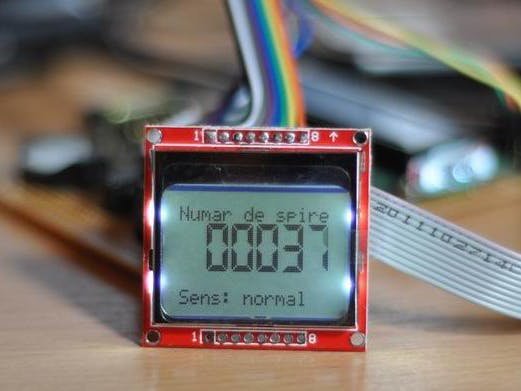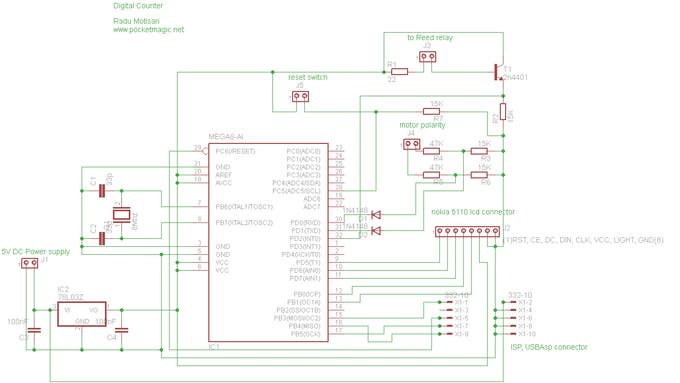Summary of Coil Winding machine counter with Atmega8 and Reed relay
The article describes a digital counter project for a coil winding machine using an Atmega8 microcontroller with different variants for LCD displays and power supplies. The main components include connectors for power, LCD, reed relay, polarity detection, reset button, and ISP programming. The circuit uses a 3.3V or 5V regulator depending on the LCD type and includes an external 8MHz crystal oscillator. The polarity connector monitors motor direction to increment or decrement the counter. Two variants support either a Nokia 5110 LCD with 3.3V or a 2x16 HD44780 LCD with 5V.
Parts used in the Coil Winding Machine Counter Project:
- Atmega8-8PU microcontroller
- Nokia 5110 LCD (variant 1)
- 2x16 HD44780 Character LCD (variant 2)
- 3.3V voltage regulator (L7833)
- 5V voltage regulator (for variant 2)
- Reed relay
- Transistor (for handling pulses from reed relay)
- External 8MHz crystal oscillator
- ISP programmer (USBAsp) connector
- Power supply connector (5V input)
- Polarity detection connector with voltage dividers (resistors R3, R4, R5, R6)
- Reset momentary switch
Connectors
Everything has been mounted on a test board, including the headers for: ISP programmer (USBAsp), the 5110 Nokia LCD, the power supply (5V in, fed to the 3.3V regulator), the Reed relay connector, the reset button connector and another 2 pins connector, used to read the polarity of coil winding machine’s motor, so we know we either increment or decrement the counter.
Connectors
There are a few connectors:
J1: is for the power supply. The circuit takes 5V, that get into the L7833 for 3.3V output used by the atmega8 uC and the LCD.
J2: is the LCD connector, going to the Nokia 5110LCD.
J3: goes to the reed relay. This is the place we generate pulses for the microcontroller to count.
J4: is the polarity connector. It must be connected in parallel on the coil winding machine’s motor. It was designed for a 12V motor (but this can be changed by adjusting the voltage dividers formed by R3-R4 and R5-R6, so they take in the motor voltage, and output not more than 5V). If the motor is connected in normal polarity, we will read PD0 high, if the motor is in inverse polarity, we’ll have PD1 high. This info is used in the code to either increment or decrement the counter.
J5: is just a simple momentary switch. When pressed, will reset the counter to zero.
ISP connector: is a 10 pin connector used with the USBAsp AVR programmer.
Fuse Bits
External 8MHz crystal. The settings are:
avrdude -p atmega8 -c usbasp -U lfuse:w:0xff:m -U hfuse:w:0xc9:mVariant 1 : Atmega8 + Nokia 5110 LCD + 3V power supply
I am using an Atmega8-8PU (configured for 8MHz with external crystal), a Nokia 5110 lcd, and a transistor to handle the pulses from a reed relay. A 3.3V regulator provides the voltage for the entire circuit.
Variant 2 : Atmega8 + 2×16 HD44780 Character LCD + 5V power supply
Some of my readers asked for a custom variant, that uses a 2×16 HD44780 LCD (or a 1×16 smaller variant). These displays require a 5V voltage supply, so here is variant 2 of the digital counter, modified to support these requirements. See the images below.
Variant 2 images
For more detail: Coil Winding machine counter with Atmega8 and Reed relay


